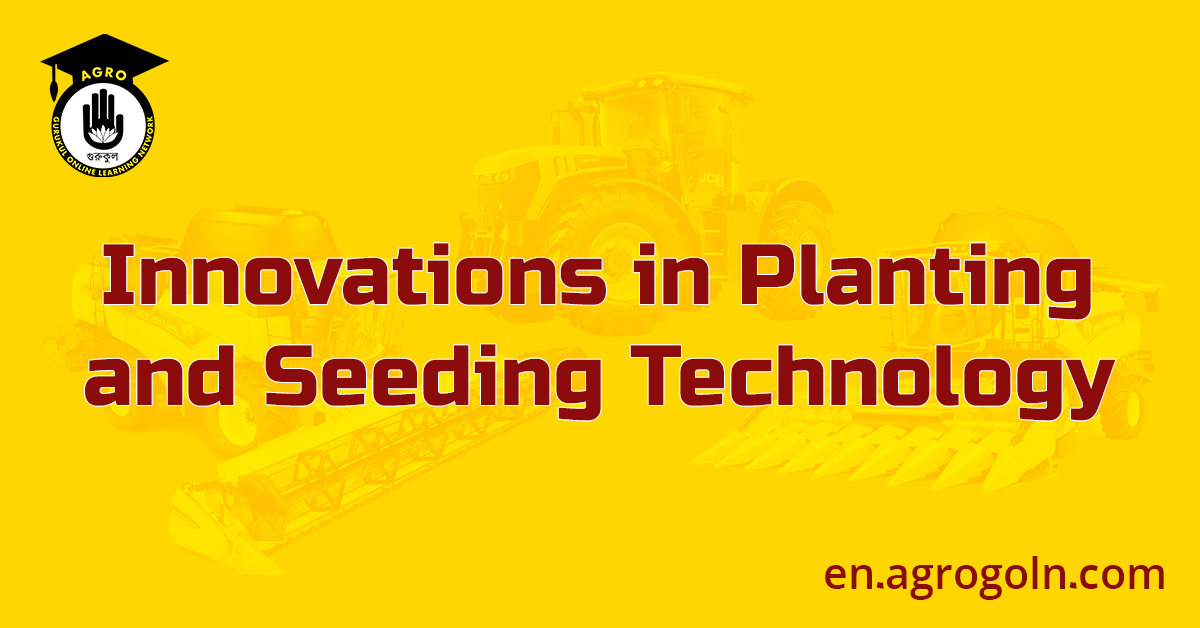Planting and seeding are critical stages in agricultural production, determining the success and efficiency of crop establishment. Over the centuries, farmers have continually refined their planting techniques to maximize yields and reduce labor. However, with the growing need for sustainable agriculture and the challenges posed by climate change and population growth, there is an increasing demand for innovative technologies in planting and seeding equipment. This article explores some of the remarkable innovations that have transformed modern agriculture, enhancing precision, sustainability, and productivity.
Innovations in Planting and Seeding Technology

- Precision Planting Technology:
Precision planting technology has revolutionized modern agriculture by providing farmers with greater control and accuracy in planting. This technology allows farmers to optimize seed placement, spacing, and depth, ensuring uniform germination and reduced competition among plants. GPS-guided tractors and planters enable precise planting along straight rows and curved contours, reducing overlaps and minimizing wasted resources.
Moreover, variable-rate planting technology tailors seed rates to varying soil conditions and productivity zones within a field. By adjusting seed rates based on soil fertility levels, historical yield data, and crop requirements, farmers can optimize plant populations, thereby maximizing yields and resource efficiency.
- Seed Coating and Treatment:
Seed coating and treatment technologies have significantly enhanced seed performance and protection. Seed coatings involve applying thin layers of materials to the seed’s surface, enhancing nutrient uptake, water absorption, and early seedling vigor. Coated seeds are less susceptible to environmental stress, ensuring better germination and establishment.
Seed treatment technologies, such as fungicides, insecticides, and biological agents, protect seeds from pests and diseases during germination and early growth stages. These treatments ensure a healthy start for the crop and reduce the need for post-emergent chemical applications.
- No-Till and Conservation Tillage:
No-till and conservation tillage practices have gained popularity due to their environmental benefits and soil health improvements. Traditional tillage involves plowing or discing the soil before planting, which can lead to soil erosion, compaction, and loss of organic matter.
In contrast, no-till and conservation tillage minimize soil disturbance, leaving crop residues on the field’s surface. This practice reduces erosion, improves water infiltration, and promotes microbial activity, enhancing soil structure and fertility. No-till planting equipment, such as seed drills and planters, has been designed to work effectively in residue-covered fields, ensuring precise seed placement and establishment.
- Interplanting and Intercropping:
Interplanting and intercropping are innovative planting techniques that involve growing multiple crops together in the same field. These practices promote biodiversity, reduce pest and disease pressure, and enhance resource use efficiency.
Companion planting, a form of intercropping, involves planting crops that benefit each other in terms of nutrient uptake, pest control, and microclimate regulation. For example, planting legumes alongside cereal crops can enhance nitrogen fixation in the soil, benefiting the entire crop rotation.
- Smart Planters and Robotics:
Advancements in automation and robotics have led to the development of smart planters that can precisely monitor and adjust planting parameters in real-time. These planters use sensors, cameras, and artificial intelligence to assess soil conditions, seed placement, and population density, ensuring optimal planting accuracy.
Furthermore, autonomous planting robots are being developed to carry out planting operations without human intervention. These robots can navigate through fields, plant seeds with precision, and operate 24/7, reducing labor demands and increasing planting efficiency.
- Drone Seeding:
Drone technology has shown great promise in the agricultural sector, including planting and seeding. Drone seeding involves using unmanned aerial vehicles to disperse seeds across large areas efficiently. This technology is particularly useful for reforestation, reclamation of degraded lands, and precision planting in challenging terrain.
Drone seeding offers speed and cost advantages, making it an attractive option for large-scale planting projects and areas with limited accessibility.
- Hydroponic and Aeroponic Systems:
Hydroponic and aeroponic systems represent innovative methods of growing crops without soil, using nutrient-rich water or air instead. These technologies allow crops to be cultivated vertically or in confined spaces, making them suitable for urban farming and resource-constrained regions.
Hydroponics and aeroponics provide precise control over nutrient delivery and environmental conditions, resulting in faster growth rates, higher yields, and reduced water usage compared to conventional soil-based agriculture.
Conclusion:
Innovations in planting and seeding technology are driving a transformative shift in modern agriculture. From precision planting and smart planters to drone seeding and hydroponic systems, these advancements are enhancing efficiency, sustainability, and resilience in farming practices.
As the world faces the challenges of feeding a growing population, mitigating climate change, and preserving natural resources, investing in innovative planting and seeding equipment becomes essential. By harnessing cutting-edge technologies and embracing sustainable practices, farmers can optimize yields, reduce environmental impact, and pave the way for a more sustainable future in agriculture. The continued development and adoption of these innovations will play a pivotal role in shaping the agriculture of tomorrow.
